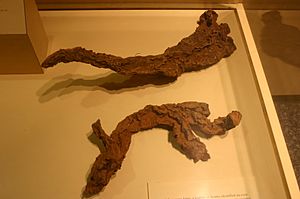Barbasco facts for kids
Quick facts for kids Barbasco |
|
|---|---|
 |
|
| Scientific classification | |
| Genus: |
Dioscorea
|
| Species: |
composita
|
Dioscorea composita, also known as barbasco, is a special type of yam plant. It grows naturally in Mexico. This plant is very important because it helps us make useful substances called diosgenin. Diosgenin is a key ingredient for creating hormones, like progesterone, which are important chemicals in our bodies.
A scientist named Russell Marker played a big role in using Dioscorea composita. He figured out how to get hormones from a similar yam, Dioscorea mexicana, at a company called Syntex. This started a big business of trading these yams in Mexico. Marker later found that Dioscorea composita had much more diosgenin than Dioscorea mexicana. Because of this, Dioscorea composita became the main yam used to make synthetic hormones.
What's Inside Barbasco?
The main important chemical found in Dioscorea composita is called diosgenin. This substance is a type of steroidal sapogenin.
How Barbasco Helps Medicine
Dioscorea composita is a great source of diosgenin. This diosgenin is used to make artificial hormones like progesterone and cortisone. Cortisone made from Dioscorea composita was very important in developing treatments for conditions like arthritis, which causes joint pain. Some studies also suggest that diosgenin might help with problems related to diabetic neuropathy, a nerve condition often linked to diabetes.
Traditional Uses of Barbasco
Before it was used in factories, the root of the barbasco plant had traditional uses. Healers from the Chinantec people in northern Oaxaca, Mexico, used it. They used it to help people with aching joints.
The Chinantec people also used barbasco as a poison for fishing in the Papaloapan river. This way of fishing is even mentioned in the Popol Vuh. The Popol Vuh is a very old and sacred book of the K'iche Maya people.

